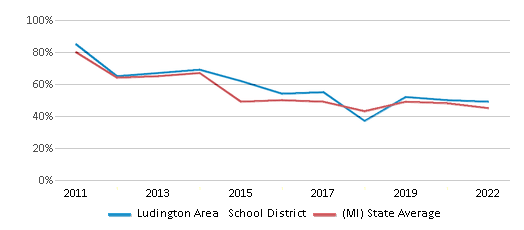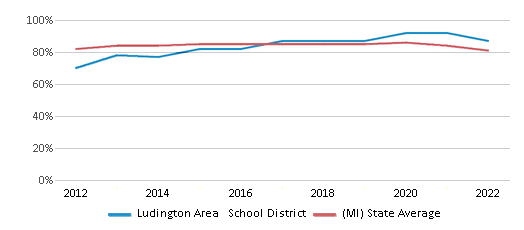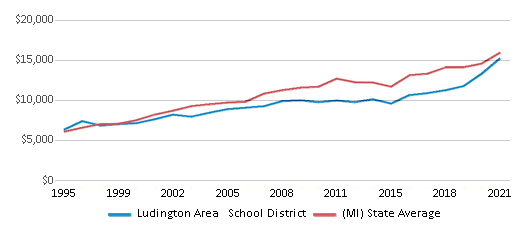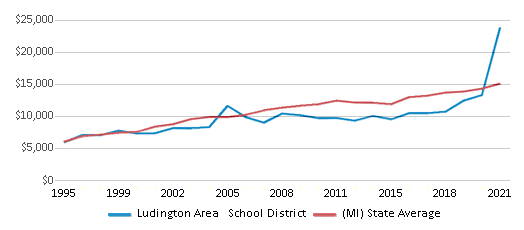For the 2025 school year, there are 2 public elementary schools serving 1,379 students in Ludington Area School District. This district's average elementary testing ranking is 7/10, which is in the top 50% of public elementary schools in Michigan.
Public Elementary Schools in Ludington Area School District have an average math proficiency score of 34% (versus the Michigan public elementary school average of 34%), and reading proficiency score of 48% (versus the 44% statewide average).
Minority enrollment is 19% of the student body (majority Hispanic), which is less than the Michigan public elementary school average of 38% (majority Black).
Overview
This School District
This State (MI)
# Schools
3 Schools
2,544 Schools
# Students
2,063 Students
953,641 Students
# Teachers
117 Teachers
58,885 Teachers
Student : Teacher Ratio
18:1
18:1
District Rank
Ludington Area School District, which is ranked within the top 50% of all 851 school districts in Michigan (based off of combined math and reading proficiency testing data) for the 2021-2022 school year.
The school district's graduation rate of 85-89% has stayed relatively flat over five school years.
Overall District Rank
#315 out of 866 school districts
(Top 50%)
(Top 50%)

Math Test Scores (% Proficient)
33%
34%

Reading/Language Arts Test Scores (% Proficient)
49%
45%

Science Test Scores (% Proficient)
45%
38%

Graduation Rate
85-89%
81%

Students by Ethnicity:
Diversity Score
0.33
0.57
# American Indian Students
8 Students
6,574 Students
% American Indian Students
n/a
1%
# Asian Students
18 Students
35,670 Students
% Asian Students
1%
4%
# Hispanic Students
233 Students
87,214 Students
% Hispanic Students
11%
9%
# Black Students
19 Students
176,246 Students
% Black Students
1%
18%
# White Students
1,670 Students
592,590 Students
% White Students
81%
62%
# Hawaiian Students
3 Students
812 Students
% Hawaiian Students
n/a
n/a
# Two or more races Students
112 Students
53,732 Students
% of Two or more races Students
6%
6%
Students by Grade:
# Students in PK Grade:
-
-
# Students in K Grade:
174
106,334
# Students in 1st Grade:
147
100,790
# Students in 2nd Grade:
152
102,777
# Students in 3rd Grade:
147
100,401
# Students in 4th Grade:
150
101,847
# Students in 5th Grade:
132
101,136
# Students in 6th Grade:
147
102,120
# Students in 7th Grade:
164
90,984
# Students in 8th Grade:
166
87,683
# Students in 9th Grade:
153
14,722
# Students in 10th Grade:
166
14,342
# Students in 11th Grade:
178
13,967
# Students in 12th Grade:
187
14,500
# Ungraded Students:
-
2,038
District Revenue and Spending
The revenue/student of $15,559 in this school district is less than the state median of $18,510. The school district revenue/student has stayed relatively flat over four school years.
The school district's spending/student of $24,379 is higher than the state median of $17,693. The school district spending/student has stayed relatively flat over four school years.
Total Revenue
$32 MM
$25,476 MM

Spending
$50 MM
$24,351 MM

Revenue / Student
$15,559
$18,510

Spending / Student
$24,379
$17,693

Best Ludington Area School District Public Elementary Schools (2025)
School
(Math and Reading Proficiency)
(Math and Reading Proficiency)
Location
Grades
Students
Rank: #11.
Oj Dejonge Middle School
(Math: 36% | Reading: 52%)
Rank:
Rank:
7/
Top 50%10
706 E Tinkham Ave
Ludington, MI 49431
(231) 845-3810
Ludington, MI 49431
(231) 845-3810
Grades: 6-8
| 477 students
Rank: #22.
Ludington Elementary School
(Math: 31% | Reading: 43%)
Rank:
Rank:
5/
Bottom 50%10
5771 W Bryant Rd
Ludington, MI 49431
(231) 845-3820
Ludington, MI 49431
(231) 845-3820
Grades: PK-5
| 902 students
Recent Articles

Year-Round Or Traditional Schedule?
Which is more appropriate for your child? A year-round attendance schedule or traditional schedule? We look at the pros and cons.

Why You Should Encourage Your Child to Join a Sports Team
Participating in team sports has a great many benefits for children, there is no doubt. In this article you will learn what those benefits are.

White Students are Now the Minority in U.S. 九游体育s
Increasing birth rates among immigrant families from Asia and Central and South America, combined with lower birth rates among white families, means that for the first time in history, public school students in the United States are majority-minority. This shift in demographics poses difficulties for schools as they work to accommodate children of varying language abilities and socio-economic backgrounds.





